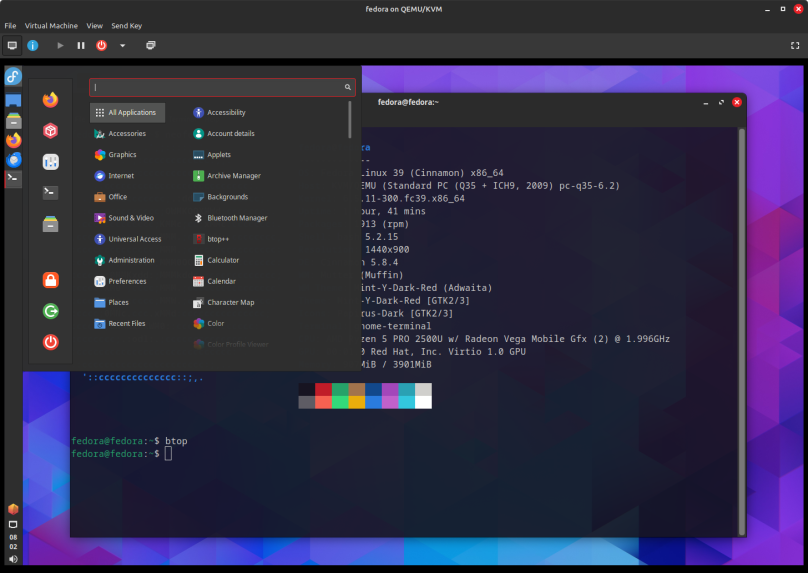This is the second of two parts where I very casually compare and contrast Fedora 39 with Red Hat Enterprise Linux (RHEL) 9.3.
When we left off I’d installed RHEL 9.2 in a qemu virtual machine. I’d done a very minimalist setup just to get a feel for how a stock RHEL installation looked and felt in operation. In order to install a legal copy of RHEL I had to register as a Red Hat developer, then register my RHEL running instance under my developer account. In the process of updating RHEL, my installation was updated to RHEL 9.3. Now we’re looking at Fedora 39.
I should note up front this isn’t Fedora Gnome. This is the Fedora Cinnamon spin. I did install Fedora Gnome first, checked out if it still had the parental control application installed, which it does. I hate some other group basically calling the shots on my machine with regards to their moral view of the world. It’s been many, many years since my adult children were living at home, and back then they ran Windows computers because Linux was just too primitive to put in front of anyone other than an adult. Now we have a group of do-gooders in the Fedora community who have decided you will run parental controls whether you need to or not, and that you cannot disable nor remove that application without crippling the graphical desktop. My response to that bullshit is “Fuck you, nobody died and made you my moral conscience.” To paraphrase the New Hampshire motto “Live Free or Die,” for me it’s “Compute Free or Die.”
As it turns out this is a “feature” of the Gnome desktop, which is just one more reason to not ever use it unless required to with RHEL. At least RHEL doesn’t have this silly bullshit in its distribution. Instead I installed the Fedora Cinnamon spin with its Cinnamon desktop. Let me state up front it’s not a prefectly pure Cinnamon desktop, but for practical purposes it’s good enough (another motto, “Don’t let perfection be the enemy of good enough.”) Once installed I then installed @development-tools, c++, clang, and the papirus-icon-theme. Everything else I needed to install was available in the Fedora repositories without having to add anything else, such as what you need to do with EPEL and RHEL.

I also need to point out that RHEL, CentOS Stream and Fedora Gnome install the brltty package, which means that if you plug anything into the USB ports of your computer that use USB for serial communication, then the brltty driver is invoked and attached to the port, making it impossible to use for anything else until that package is removed. I had to remove brltty under all three. I’m assuming this is another Gnome “feature” as it is not installed with the Fedora Cinnamon spin. That makes two big check marks in favor of the Cinnamon spin, the first being the lack of the parental controls application.
The greatest feature about using a Fedora distribution is the distribution’s adherence to always using the most up-to-date versions of any tool you have installed. Right off the bat I checked the Python version, which is 3.12. That version is so newly released that the paint on it is still a bit wet. The GCC and CLANG compiler tools are all the latest releases, which means they support the latest language standards. If you can find a Fedora version that suits you, then you can’t go wrong. The only “better” alternative might be Arch, but Arch is a rolling release, and I’ve been burned too many times by Arch committing update suicide to ever run it again.
Whether I move off Linux Mint is still unanswered at this point. What I will move to is also unanswered, although I’m strongly in favor of Fedora in spite of its nine month limited lifespan. Debian and, for that matter, LMDE, should be considered contenders, if for no other reason than they’re ahead of Linux Mint with regards to the currency of its software environment. But they are still behind (sometimes quite behind) of Fedora.
The greatest issue is properly setting up an environment that matches what I currently have under Linux Mint. I’ve expended a fair amount of effort over time to tune my instance of Linux Mint to be just what I want. Do I really want to go through that again? Another motto: Be careful what you ask for.



You must be logged in to post a comment.